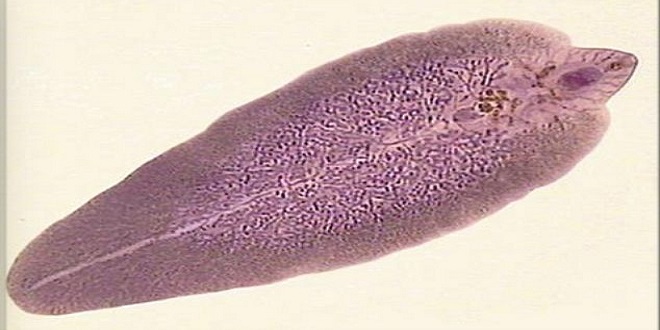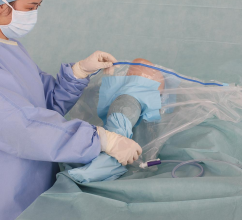Platyhelmintha (syn. Platyhelminthes) Trematoda (Flukes)

General. Most of the trematode species that parasitize humans are dorsoventrally flattened with an oval to lancet shape, although others have different shapes such as the threadlike schistosomes. Suckers (trema: hole, opening) serve as attachment organs: an oral sucker around the mouth connected to the esophagus and the blind-ending intestine, and a ventral sucker.
The body surface of adult trematodes is covered by a cellular tegument(composed of an outer annucleate, syncytial layer of cytoplasm connected by cytoplasmic strands to inner nucleated portions) through which substances can be absorbed from the environment. Most species are hermaphroditic, only the schistosomes have separate sexes. Snails are the first intermediate hosts; some species require arthropods or fish as second intermediate hosts.
Schistosoma (Blood Flukes)
schistosomiasis (bilharziosis) is one of the most frequent tropical diseases with about 200 million infected persons. The occurrence of schistosomiasis depends on the presence of suitable intermediate hosts (freshwater snails). Human infections result from contact with standing or slow-moving bodies of water (freshwater) when Schistosoma cercariae penetrate the skin.
Schistosoma crematorium causes urinary schistosomiasis; S. mansoni, S. japonicum, S. intercalatum, and S. mekongi are the causative agents of intestinal schistosomiasis and other forms of the disease. Diagnosis can be made by detection of either Schistosoma eggs in stool or urine or of specific antibodies in serum
Schistosomiasis is also known as bilharziosis after the German physician Th. Bilharz, who discovered Schistosoma crematorium in human blood vessels in 1851. Schistosomosis occurs endemically in 74 tropical and subtropical countries of Africa, South America, and Asia . The number of persons infected with schistosomes is estimated at 200 million (WHO, 2004). The most important species pathogenic to humans are Schistosoma hematobium (Africa, the Near East, and questionable occurrence in India), S. mansoni (Africa, the Caribbean, the north-east of South America).
At the site of their deposition, the eggs lie in chainlike rows within small veins. Some penetrate through the vascular wall and surrounding tissue to reach the lumen of the urinary bladder or intestine (regarding the eggs that remain in the body see section on pathogenesis). Enzymes produced by the miracidium and secreted through micropores in the eggshell and granuloma formation (see below) contribute to the penetration process.
The eggs are shed by the definitive host in stool or urine within a few weeks post infection (p.i.) (see below). If the eggs are deposited into freshwater, the miracidia hatch from the eggshell and begin their search for a suitable intermediate host .
Infection ! schistosomula penetrate subcutaneous tissues ! find venous capillaries or lymph vessels ! migrate through the venous circulatory system into the right ventricle of the heart and the lungs ! travel hematogenously into the intrahepatic portal vein branches where development into adult worms takes place as wells as male-female pairing just prior to sexual maturity ! retrograde migration of pairs into mesenteric veins or to the vesical plexus
Last word
Although the cycles of all Schistosoma species can include animals as hosts, humans are the most important parasite reservoirs (Table 10.2). However, animals contribute significantly to the dissemination of the eggs of S. japonicum and S. mekongi. Travelers to endemic tropical areas can acquire the infection by a single instance of contact with water containing cercariae.
In the world of music, Naa Songs stands out as a hub for diverse melodies across genres. Dive into a realm of soul-soothing tunes and rhythmic beats that cater to every mood. Experience the magic of music with Naa Songs and elevate your auditory journey to new heights





